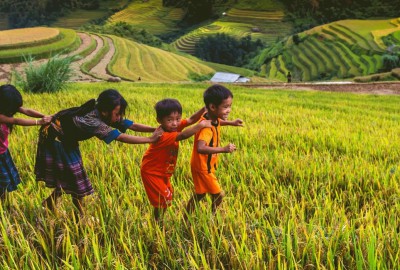Here are top things to do in Cao Bang you must not miss.
Bản Giốc Waterfall

Located on the border between China and Vietnam, Bản Giốc is the fourth largest waterfall in the world. Measuring 300 meters wide, the falls are absolutely breathtaking in size. The vast area and range of different falls and pools within the park is captivating. Set in a striking valley and surrounded by lush jungle, Bản Giốc feels like a paradise of its own.
TIP: The best time to visit is during the dry season from October to April. At the end of the dry season, a daily release of water from the dam-controlled Quây Sơn River takes place between 10:30am and 1:00pm, bringing the falls up to their full flow.
Trúc Lâm Phật Tích Pagoda

A short but steep walk brings you to this traditional Vietnamese-style temple. The design of Trúc Lâm pagoda fits perfectly into the hillside. As you climb higher to the main temple area, a valley filled with karsts unfolds below. A stunning spot not far from Bản Giốc Waterfalls, Trúc Lâm Pagoda can easily be visited in the same day.
Ngườm Ngao Cave

The Ngườm Ngao cave system has some of the most unique stalactite formations in Southeast Asia. As you step foot into the cave, the formations change with each new cavern. The entire cave system is 2,144 meters long, but local authorities have only opened 948 meters to visitors to preserve its natural beauty.
TIP: Don’t forget to bring drinking water for this trip: the one-kilometre walk can easily take an hour or more.
Thang Hen Lake System

The Thang Hen Lakes are made up of 36 miniature lakes that are all connected through caves and underground passageways. In the rainy season, water levels rise to form a single lake, which meanders through a valley of karst peaks for over 300 kilometres. While the lake is picturesque, it’s the rock formations and scenes of daily life that make Thang Hen worth visiting.
TIP: Hire a local guide to bring you to Tuyệt Tình Cốc, also known as The Mountains Eye. This single karst peak is home to a cave that runs through one side to the other, forming a giant hole in the mountain.
Ethnic minority groups

Cao Bằng Province has over nine ethnic groups, which have lived in these valleys for centuries. The Tày, Nùng, Dao, and H’mong are some of the most well-known, and each minority has its own special crafts and way of living. To experience ethnic culture, visit a minority craft village with one of the local guides, or book an ethnic homestay during your trip.
Cao Bằng City
Anchored around the Sông Bằng River, Cao Bằng City has grown into a bustling centre of development. With a small but contemporary selection of hotels, shops, and restaurants, it’s the perfect base for exploring the rest of the province. You’ll find many northern specialities to try in town, such as Phở Chua (sour noodle soup) and Bánh Cuốn (steamed rice rolls). Cao Bang City also has several festivals which are unique to the region.
Pác Bó Historical Complex

Pác Bó Historical Complex is a memorial and museum founded on the site where Hồ Chí Minh began his revolution. Here you can take a look at the cave where Ho Chi Minh lived in hiding, and the river where he fished and wrote poetry. This tasteful tribute to the life and work of Ho Chi Minh is an important pilgrimage spot for the Vietnamese.
Festivals and Events
Long Tong Festival

Long Tong Festival is one of the biggest Tay celebrations of the year. The festival takes place throughout many Tay villages in the north of Vietnam on the 4th day of the lunar year. The spring festival is a chance for the villagers to worship the god of agriculture and pray for prosperous crops in the upcoming year. People prepare offerings of food for the gods and then celebrate with a feast and lively traditional games.
Moi Me Trang Festival
Another Tay festival, held in the Dong Khe region of Cao Bang is Moi Me Trang which means Mother Moon Festival. This is another spring festival which brings the local villagers together to celebrate and pray for prosperity. In particular, this festival is a chance to ask the moon for luck. The celebrations start with a beautiful ceremony of traditional singing and flower offerings which are followed by cultural activities and games.



























